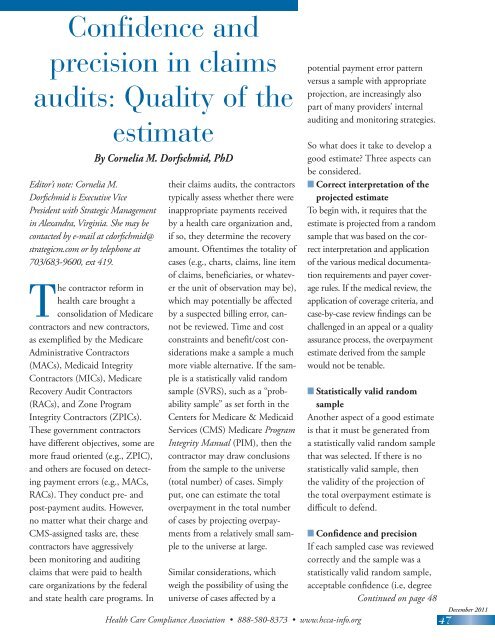Quality of the estimate. December, p. 47 - Health Care Compliance ...
Quality of the estimate. December, p. 47 - Health Care Compliance ...
Quality of the estimate. December, p. 47 - Health Care Compliance ...
You also want an ePaper? Increase the reach of your titles
YUMPU automatically turns print PDFs into web optimized ePapers that Google loves.
Confidence and<br />
precision in claims<br />
audits: <strong>Quality</strong> <strong>of</strong> <strong>the</strong><br />
Editor’s note: Cornelia M.<br />
Dorfschmid is Executive Vice<br />
President with Strategic Management<br />
in Alexandra, Virginia. She may be<br />
contacted by e-mail at cdorfschmid@<br />
strategicm.com or by telephone at<br />
703/683-9600, ext 419.<br />
The contractor reform in<br />
health care brought a<br />
consolidation <strong>of</strong> Medicare<br />
contractors and new contractors,<br />
as exemplified by <strong>the</strong> Medicare<br />
Administrative Contractors<br />
(MACs), Medicaid Integrity<br />
Contractors (MICs), Medicare<br />
Recovery Audit Contractors<br />
(RACs), and Zone Program<br />
Integrity Contractors (ZPICs).<br />
These government contractors<br />
have different objectives, some are<br />
more fraud oriented (e.g., ZPIC),<br />
and o<strong>the</strong>rs are focused on detecting<br />
payment errors (e.g., MACs,<br />
RACs). They conduct pre- and<br />
post-payment audits. However,<br />
no matter what <strong>the</strong>ir charge and<br />
CMS-assigned tasks are, <strong>the</strong>se<br />
contractors have aggressively<br />
been monitoring and auditing<br />
claims that were paid to health<br />
care organizations by <strong>the</strong> federal<br />
and state health care programs. In<br />
<strong>estimate</strong><br />
By Cornelia M. Dorfschmid, PhD<br />
<strong>the</strong>ir claims audits, <strong>the</strong> contractors<br />
typically assess whe<strong>the</strong>r <strong>the</strong>re were<br />
inappropriate payments received<br />
by a health care organization and,<br />
if so, <strong>the</strong>y determine <strong>the</strong> recovery<br />
amount. Oftentimes <strong>the</strong> totality <strong>of</strong><br />
cases (e.g., charts, claims, line item<br />
<strong>of</strong> claims, beneficiaries, or whatever<br />
<strong>the</strong> unit <strong>of</strong> observation may be),<br />
which may potentially be affected<br />
by a suspected billing error, cannot<br />
be reviewed. Time and cost<br />
constraints and benefit/cost considerations<br />
make a sample a much<br />
more viable alternative. If <strong>the</strong> sample<br />
is a statistically valid random<br />
sample (SVRS), such as a “probability<br />
sample” as set forth in <strong>the</strong><br />
Centers for Medicare & Medicaid<br />
Services (CMS) Medicare Program<br />
Integrity Manual (PIM), <strong>the</strong>n <strong>the</strong><br />
contractor may draw conclusions<br />
from <strong>the</strong> sample to <strong>the</strong> universe<br />
(total number) <strong>of</strong> cases. Simply<br />
put, one can <strong>estimate</strong> <strong>the</strong> total<br />
overpayment in <strong>the</strong> total number<br />
<strong>of</strong> cases by projecting overpayments<br />
from a relatively small sample<br />
to <strong>the</strong> universe at large.<br />
Similar considerations, which<br />
weigh <strong>the</strong> possibility <strong>of</strong> using <strong>the</strong><br />
universe <strong>of</strong> cases affected by a<br />
<strong>Health</strong> <strong>Care</strong> <strong>Compliance</strong> Association • 888-580-8373 • www.hcca-info.org<br />
potential payment error pattern<br />
versus a sample with appropriate<br />
projection, are increasingly also<br />
part <strong>of</strong> many providers’ internal<br />
auditing and monitoring strategies.<br />
So what does it take to develop a<br />
good <strong>estimate</strong> Three aspects can<br />
be considered.<br />
n Correct interpretation <strong>of</strong> <strong>the</strong><br />
projected <strong>estimate</strong><br />
To begin with, it requires that <strong>the</strong><br />
<strong>estimate</strong> is projected from a random<br />
sample that was based on <strong>the</strong> correct<br />
interpretation and application<br />
<strong>of</strong> <strong>the</strong> various medical documentation<br />
requirements and payer coverage<br />
rules. If <strong>the</strong> medical review, <strong>the</strong><br />
application <strong>of</strong> coverage criteria, and<br />
case-by-case review findings can be<br />
challenged in an appeal or a quality<br />
assurance process, <strong>the</strong> overpayment<br />
<strong>estimate</strong> derived from <strong>the</strong> sample<br />
would not be tenable.<br />
n Statistically valid random<br />
sample<br />
Ano<strong>the</strong>r aspect <strong>of</strong> a good <strong>estimate</strong><br />
is that it must be generated from<br />
a statistically valid random sample<br />
that was selected. If <strong>the</strong>re is no<br />
statistically valid sample, <strong>the</strong>n<br />
<strong>the</strong> validity <strong>of</strong> <strong>the</strong> projection <strong>of</strong><br />
<strong>the</strong> total overpayment <strong>estimate</strong> is<br />
difficult to defend.<br />
n Confidence and precision<br />
If each sampled case was reviewed<br />
correctly and <strong>the</strong> sample was a<br />
statistically valid random sample,<br />
acceptable confidence (i.e, degree<br />
Continued on page 48<br />
<strong>December</strong> 2011<br />
<strong>47</strong>

















